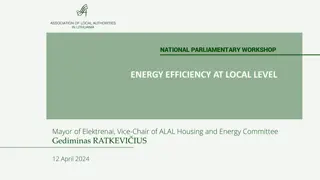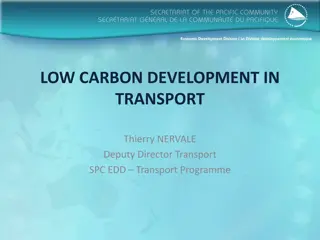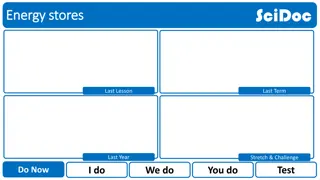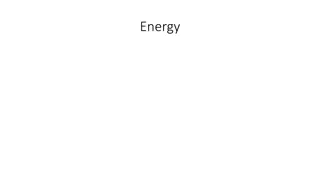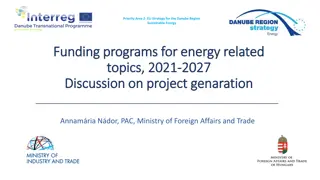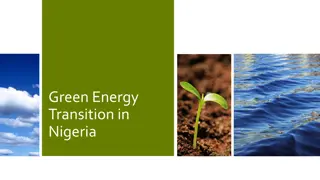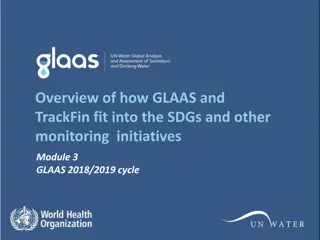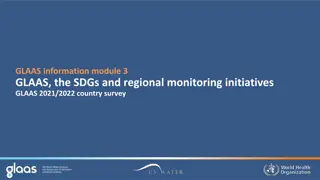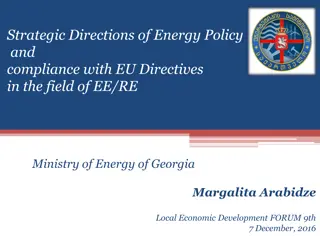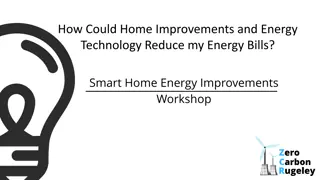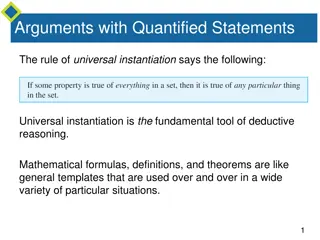Sustainable Development Goal 7: Ensuring Universal Access to Modern Energy
Sustainable Development Goal 7 focuses on ensuring access to affordable, reliable, sustainable, and modern energy for all by 2030. The goal is broken down into three main targets, with clear indicators and established methodologies for measurement. Coordinated efforts by leading agencies and groups are in place to track progress towards achieving this goal.
Download Presentation

Please find below an Image/Link to download the presentation.
The content on the website is provided AS IS for your information and personal use only. It may not be sold, licensed, or shared on other websites without obtaining consent from the author.If you encounter any issues during the download, it is possible that the publisher has removed the file from their server.
You are allowed to download the files provided on this website for personal or commercial use, subject to the condition that they are used lawfully. All files are the property of their respective owners.
The content on the website is provided AS IS for your information and personal use only. It may not be sold, licensed, or shared on other websites without obtaining consent from the author.
E N D
Presentation Transcript
Alex Blackburn UNSD 10th Oslo Group Meeting 10-13 May 2016 Aguascalientes, Mexico http://unstats.un.org/unsd/energy
Current work of UNSD Making publications IRES-compliant SDGs: International process The energy goal Technical cooperation Biomass review
IRES-compliant books Old energy Yearbook used consumption for something similar to Total Energy Supply, and commercial energy which is no longer distinguished in IRES. (Etc.) The book has now been updated to agree completely with IRES terminology Energy Balances and Electricity Profiles (previously the same publication) split and revised, now IRES-compliant too
SDGs: Historical Context As a follow-on to the Millennium Development Goals (which spanned 2000-2015 and did not include energy), the post-2015 development agenda was negotiated and agreed by the UN General Assembly in 2015 Statistics is at the forefront
Measuring the SDGs At the 46th session, the Statistical Commission established the Inter-Agency Expert Group on the Sustainable Development Goals (IAEG-SDGs) The group comprises member states, with international and regional organisations as observers (national ownership is key) Its mandate is to develop an indicator framework to measure the 17 goals and 169 targets Indicators for each target have now been proposed and classified into three tiers, relating to status of methodology and data collection
SDG7 and its Targets Sustainable Development Goal 7: Ensure access to affordable, reliable, sustainable and modern energy for all Broken down into three main targets (plus two additional targets relating to means of implementation) Target 7.1: By 2030, ensure universal access to affordable, reliable and modern energy services Target 7.2: By 2030, increase substantially the share of renewable energy in the global energy mix Target 7.3: By 2030, double the rate of improvement in energy efficiency Unlike some other goals, the targets for Energy are (reasonably) clear to measure, established methodology exists and indicators are already available (thus all tier I)
SDG7: Process for indicators For SDG 7, inputs have been coordinated by leading agencies and umbrella groups on energy statistics, such as: UNSD, UN-Energy, SE4all, Worldbank Some representatives also attended as observers at the IAEG meetings to present the inputs
SDG7: Process for indicators Inputs provided so far: Proposals for indicators that have agreed methodology and existing data collections Arguments against other proposed indicators that did not Metadata for energy indicators Currently still being discussed by the IAEG with inputs provided by the energy agencies: Finalization of metadata Organization of data collection process at world-wide level and identification of lead agencies Indicators for means of implementation (7.a and 7.b) are still under review (Current proposals are out of scope of actual energy statistics and are Tier III)
SDG 7 indicators 7.1.1: % of population with electricity access 7.1.2 % of population with primary reliance on clean fuels and technology 7.2.1: renewable energy share in total final energy consumption (%) 7.3.1: energy intensity measured in terms of primary energy and GDP World Bank WHO IEA & UNSD energy balances The SE4all Global Tracking Framework brings data together from different sources
SDGs: IAEG work plan Sub-groups set up on SDMX, Geospatial information, interlinkages between goals The IAEG-SDGs will develop a plan to review the indicator framework to present to the next UNSC. The data flows from national to international level are still to be determined, as are baseline years Tier III indicator proposals to be made by July and finalised by September Data disaggregation (by income, sex, urban vs rural etc.) is seen as key to reflect the no-one left behind approach. Is this relevant/possible for energy?
SDG7: UNSD technical cooperation Two regional workshops in 2015 organised by UN DESA s Division for Sustainable Development, in Panama and Korea Title: Mainstreaming energy SDGs, targets and indicators into statistical programmes of countries A great way to promote IRES as a practical tool, highlights the benefits of harmonisation Allowed countries to see how others are integrating the SDG targets into their statistics systems A third workshop for African countries is planned for June; China workshop in 2 weeks will cover similar topics
SDGs, Green Economy With so many SDG indicators and just a few related to energy, UNSD launched a project on the Green Economy that includes energy as one of its priorities: http://unstats.un.org/unsd/greeneconomy/ Goal of the project is to strengthen national statistical systems in developing countries to enable them to effectively produce statistical indicators on green economy and green growth in the context of sustainable development. 12
Green economy energy indicators The green economy project focuses on indicators more purely derived from energy statistics. In this respect, they align with the SDG ones while being a bit more detailed. Energy 2.2 Core set 2.2.1 Energy productivity [US$ per ktoe] No 2.2.2 Energy consumption per capita [total or final] Yes 2.2.3Energy intensity by sector [manufacturing, transport, households, services] No 2.2.4 Renewable energy supply [% total energy supply ,TES] Yes 2.2.5 Renewable electricity [% total electricity generation] No 2.2.6 Fuelwood, production [thousand cubic metres] No 2.2.7 Proportion of bioenergy in total renewable energy production No 13
Green Economy Conclusion Countries must identify policy priorities and goals, then strengthen their national statistical systems in order to provide relevant indicators Energy GEIs will not be enough for national purposes, even if they are more detailed than SDG7 Countries are thus encouraged to complement these indicators with those relevant to their circumstances 14
Biomass Review Primary Solid Biofuels are 7.9% of Global TES (2013), but 48% of African TES, and as high as 90%+ in some countries Fuelwood is the majority of this, around 63% But there are very big differences between IEA, UNSD and FAO numbers
World fuelwood production 2000-2013 35,000 68% 33,000 66% 31,000 64% 29,000 FAO (1) / IEA % ratio 62% 27,000 Perajoules 60% 25,000 58% 23,000 56% 21,000 54% 19,000 52% 17,000 15,000 50% 2000 2001 2002 2003 2004 2005 2006 2007 2008 2009 2010 2011 2012 2013 IEA FAO (1) wood fuel only UNSD FAO (2) all categories FAO (1) / IEA (%)
Data collected Definitions (FAO) FAO IEA/UNSD Products Coniferous and non-coniferous fuelwood: roundwood that will be used as fuel for purposes Wood Fuel (C and NC) Yes such as cooking, heating or power production Wood that has been reduced to small pieces and is suitable for pulping, for particle board and/or fibreboard production, for use as a fuel, or for other purposes. Other wood processing co-products. It includes wood waste and scrap not useable as timber and wood residues that will be used for production of pellets and other agglomerated products Agglomerates produced compression or by the addition of a binder in a proportion not exceeding 3% by weight. Such pellets are cylindrical, with a diameter not exceeding 25 mm and a length not exceeding 100 mm. Agglomerates other than wood pellets, for example briquettes or logs. It comprises any waste wood fibre after at least one life cycle. It comprises wood from construction, renovation and demolition, but also packaging as well as old furniture Chips and Particles Yes Yes Wood Residues Yes (only if used as a either directly by source of energy) Wood Pellets Yes Other Agglomerates Recovered post- consumer wood Yes No
Units of measurement UNSD data on fuelwood are collected in thousand cubic metres FAO data on wood fuel, chips and particles and wood residues are collected in cubic metres. Data on wood pellets and other agglomerates are collected in metric tons. Data are collected separately for each product. IEA data on fuelwood are collected in TJ (as a memo item, part of primary solid biofuels) For the purposes of this comparison the NCV used to convert data into terajoules is 9.135 TJ/1000 cubic metre.
Fuelwood production, 2013 Major countries 4,500 4,000 3,500 3,000 Petajoules 2,500 2,000 1,500 1,000 500 0 India China Nigeria United States Indonesia Ethiopia Brazil Dem. Rep. Congo Pakistan Un. Rep. Tanzania IEA FAO - Wood Fuel FAO - Wood Fuel, Chips and Particles, Wood Residues, Wood Pellets and Other Agglomerates FAO - Wood Fuel, Chips and Particles, Wood Residues, Wood Pellets, Other Agglomerates and Recovered Post-Consumer Wood (from JWEE)
Why the differences? Some theories: Use of a standard NCV across countries and products, could be (very) wrong? Scope of the data collection, possible exclusion/inclusion of products used/not used for energy Post-consumer recovered wood is explicitly excluded from the FAO statistics Estimation methods: 82% of FAO fuelwood production is from modelled data (official data 15%, unofficial sources 3%). IEA data can be estimated/modelled too. Which estimates are less wrong?
THANKS http://unstats.un.org/unsd/energy/default.htm http://unstats.un.org/sdgs/





